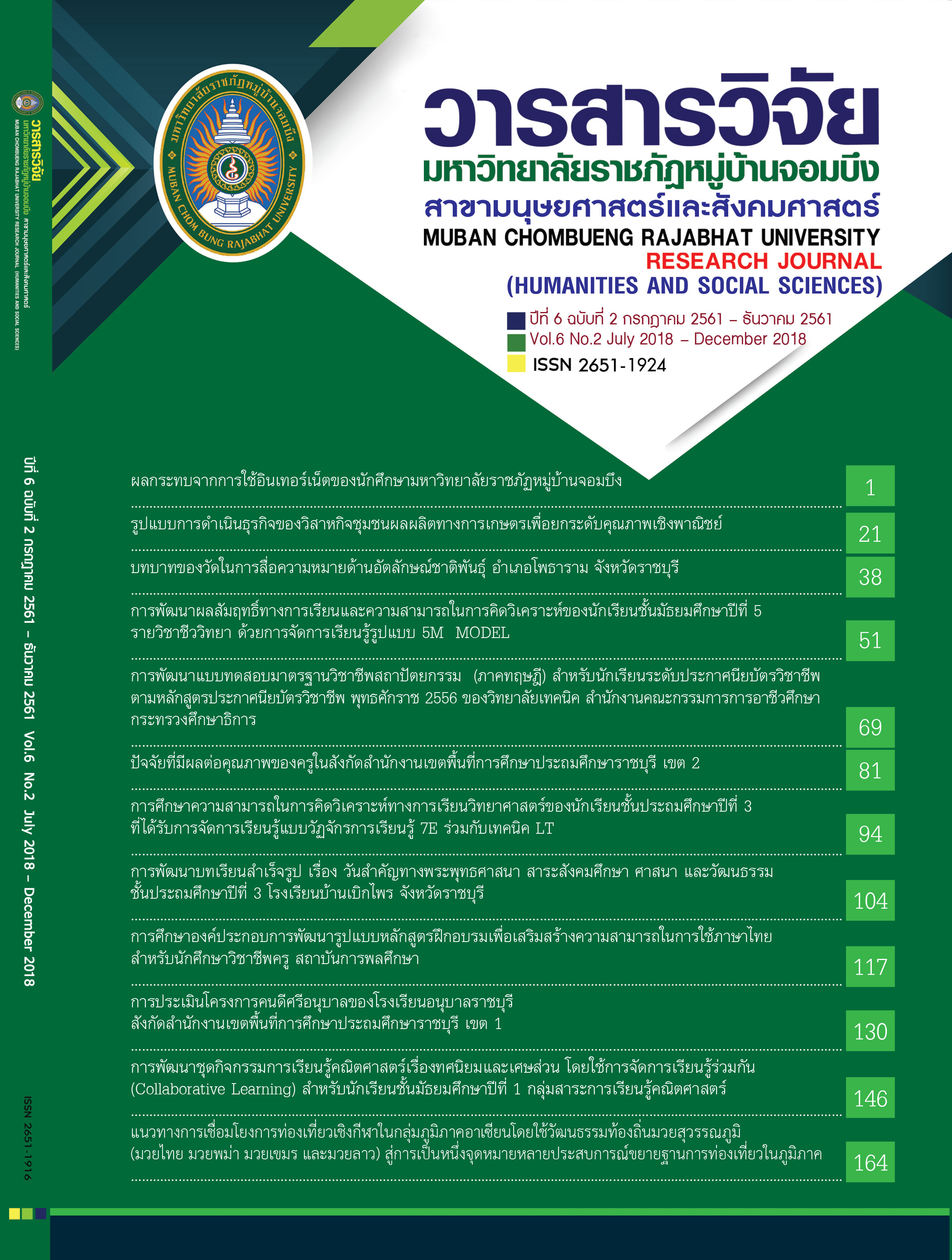A Business Operational Model of Community Enterprises for Agricultural Products, to Escalate the Commercial Quality
Keywords:
Business operation, Community enterprises, Agricultural products, Models of community enterprisesAbstract
The objectives of the research were to 1) explore the current conditions of the business operation of the community enterprises of the agricultural products, 2) study the levels of the factors to enhance the business operation, in terms of the commercial quality, 3) identify the factors affecting the performance of the business operation of the community enterprises for the agricultural products, and 4) propose the business operational model for the community enterprises to promote the commercial quality. Mixed Methods was used in this study, based on the qualitative approach. The target group included 19 business members, related in the business operation of the community enterprises of agricultural products. Data were collected by using In-depth Interview until the data were eventually saturated. The samples were drawn by using Snowball Sampling. The data collected were analytically synthesized. For those quantitative data collection, the sample group consisted of 498 chairmen and the representatives from the community enterprises, which were awarded a good score from internal business assessment. The sample size was determined by Newman’s formula. Stratified Sampling was employed to select the samples. The tools for data collection included questionnaire. Data were analyzed by using frequency, percentage, mean, S.D., Multiple Linear Regression and content analysis.
References
คณะทำงานถอดบทเรียนวิสาหกิจชุมชนดีเด่น. (2556). แนวทางการถอดบทเรียนวิสาหกิจชุมชนดีเด่น. สืบค้นเมื่อ 31 มีนาคม 2560, จาก http://www.sceb.doae.go.th/pr4-sceb.html.
ธงพล พรหมสาขา ณ สกลนคร. (2556). แนวทางการพัฒนาการดำเนินงานของวิสาหกิจชุมชนในเขตลุ่มทะเลสาบสงขลา. สงขลา: คณะศิลปศาสตร์ มหาวิทยาลัยสงขลานครินทร์ วิทยาเขตหาดใหญ่.
ธนัณชัย สิงห์มาตย์ และพรรษวดี พงษ์ศิริ. (2559). การใช้รูปแบบการจัดการความรู้เพื่อเพิ่มศักยภาพของวิสาหกิจชุมชนในจังหวัดมหาสารคาม. วารสารช่อพะยอม, 27(1), 265-280.
นงลักษณ์ ทองศรี. (2559). รูปแบบการจัดการของกลุ่มวิสาหกิจชุมชนผลิตภัณฑ์ผ้าไหมจังหวัดบุรีรัมย์. ปรัชญาดุษฎีบัณฑิต สาขาวิชาภาวะผู้นำเพื่อการพัฒนาวิชาชีพ มหาวิทยาลัยราชภัฏบุรีรัมย์
นุจรี ภาคาสัตย์ และธีรัตม์ พิริยะพลิน. (2558). โมเดลความสัมพันธ์เชิงสาเหตุนวัตกรรมผลิตภัณฑ์. วารสารวิชาการVeridian - E-Journal. 8(2).
บุญฑวรรณ วิงวอน. (2556). การเป็นผู้ประกอบการยุคโลกาภิวัตน์. กรุงเทพฯ: แอคทีฟพริ้นท์.
พยัต วุฒิรงค์. (2557). การจัดการนวัตกรรม: ทรัพยากร องค์การแห่งการเรียนรู้และนวัตกรรม. กรุงเทพฯ: วี.พริ้นท์ (1991).
ฟิลิปคอตเลอร์ และมิลตัน คอตเลอร์. (2556). 8 เส้นทางสู่ชัยชนะ: การตลาดเพื่อสร้างการเติบโตทางธุรกิจ.แปลโดย ณงลักษณ์ จารุวัฒน์ จาก Market Your Way to Growth. กรุงเทพฯ: เนชั่นบุ๊คส์.
ส่วนบริหารจัดการงานส่งเสริมวิสาหกิจชุมชนและเครือข่าย. (2560). ผลการประเมินศักยภาพวิสาหกิจ ชุมชน. สืบค้นเมื่อ 31 มีนาคม 2560, จาก http://www.sceb.doae.go.th/EVALUATION.html.
เสรี พงศ์พิศ. (2546). แผนชีวิตเศรษฐกิจชุมชน. กรุงเทพฯ: ภูมิปัญญาไทย.
สุเมธ สมภักดี. (2550). ทฤษฎีการเลือกตัวอย่าง. กรุงเทพฯ: โฟร์พริ้นท์ติ้ง.
สาทิตร์ ม่วงหมี, ศลิล วัชรพงษ์กิตติ และสุดาพร สาวม่วง. (2557). รูปแบบการตลาดที่ยั่งยืนของธุรกิจขนาดย่อมตามหลักปรัชญาเศรษฐกิจพอเพียง. วารสารสมาคมนักวิจัย. 19(1), 20-33.
สำนักงานเลขานุการคณะกรรมการส่งเสริมวิสาหกิจชุมชน. (2560). จำนวนสมาชิกวิสาหกิจชุมชนจำแนก ตามพื้นที่. สืบค้นเมื่อ 15 ตุลาคม 2560, จาก http://smce.doae.go.th/smce1/report/ report_graph_smce_member.phplevelSearch=2®ion=2&province=&hur =&smce_type=1.
Fairoz, F. M., T. Hirobumi and Y. Tanaka (2010). Entrepreneurial Orientation and Business Performance of Small and Medium Scale Enterprises of Hambantota District Sri Lanka. Asian Social Science. 6, 34-46.
Micheels, E.T., & Gow, H.R. (2015). The Effect of Market Orientation on Learning, Innovativeness, and Performance in Primary Agriculture. Canadian Journal of Agricultural Economics. 63(2), 209-233.
Philip, M. (2010). Factors Affecting Business Success of Small & Medium Enterprises (SMEs). APJRBM. 1(2).
Wiklund, J., & Shepherd, D. (2005). Entrepreneurial orientation and small business performance: A configurational approach. Journal of business venturing. 20(1), 71-91.
Yang, C.C. (2008). Establishment of a quality management system for service industries. Total Quality Management. 17(9), 1129-1154.
Downloads
Published
How to Cite
Issue
Section
License
Journal of TCI is Licensed under a Creative Commons Attribution-NonCommercial-NoDerivatives 4.0 International (CC BY-NC-ND 4.0) licence, unless otherwise stated, Please read our Policies page for more information on Open Access, copyright and permissions.



